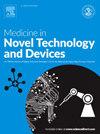应用眼动追踪技术对脑卒中后踝关节运动-认知双任务的定量研究与评价
Q3 Medicine
引用次数: 0
摘要
双重任务能力对日常生活至关重要,但感觉、认知和运动障碍往往会降低患者的表现,严重影响他们的生活质量。为了评估和恢复这种能力,本研究提出了一种基于眼动追踪的踝关节运动和认知双任务训练系统。该系统旨在捕获和分析实时脚踝和眼球运动参数,并将其与传统的临床量表相结合,提供多维、客观和定量的评估标准。对20名健康成人和30名脑卒中患者进行的信度和效度分析表明,88.2%的评价参数具有高度一致性,55.8%的评价参数与临床基准量表具有中度相关性(p <;0.05)。值得注意的是,蒙特利尔认知评估(MOCA)、双任务成本百分比和拖减任务持续时间被确定为双任务能力的关键指标,而焦虑自评量表的敏感性较低。此外,足部和踝关节运动参数与平衡和跌倒风险有很强的相关性,可以有效地预测中风患者的运动功能恢复和跌倒风险。该系统为评估下肢双任务能力提供了一种创新的定量工具,有助于识别脑卒中患者双任务表现的差异。它支持循证康复策略的发展,具有增强长期功能恢复和改善患者生活质量的潜力。本文章由计算机程序翻译,如有差异,请以英文原文为准。
Medicine in novel technology and devices quantitative study and evaluation of ankle joint motor-cognitive dual-task post-stroke using eye-tracking technology
Dual-task ability is crucial for daily life, but sensory, cognitive, and motor impairments often reduce performance in patients, significantly impacting their quality of life. To evaluate and restore this ability, this study proposes an eye-tracking-based dual-task training system for ankle movement and cognition. The system is designed to capture and analyze real-time ankle and eye movement parameters, integrating these with traditional clinical scales to offer a multidimensional, objective, and quantitative evaluation standard. Reliability and criterion validity analyses involving 20 healthy adults and 30 stroke patients demonstrated that 88.2 % of the evaluation parameters exhibited high consistency, with 55.8 % showing a moderate correlation with clinical benchmark scales (p < 0.05). Notably, the Montreal Cognitive Assessment (MOCA), dual-task cost percentage, and TUG-subtraction task duration were identified as key indicators of dual-task ability, while the Self-Rating Anxiety Scale showed lower sensitivity. Furthermore, foot and ankle motion parameters exhibited a strong correlation with balance and fall risk, effectively serving as predictors of motor function recovery and fall risk in stroke patients. The system provides an innovative, quantitative tool for assessing lower limb dual-task ability, facilitating the identification of dual-task performance differences among stroke patients. It supports the development of evidence-based rehabilitation strategies, with the potential to enhance long-term functional recovery and improve patients' quality of life.
求助全文
通过发布文献求助,成功后即可免费获取论文全文。
去求助
来源期刊

Medicine in Novel Technology and Devices
Medicine-Medicine (miscellaneous)
CiteScore
3.00
自引率
0.00%
发文量
74
审稿时长
64 days
 求助内容:
求助内容: 应助结果提醒方式:
应助结果提醒方式:


